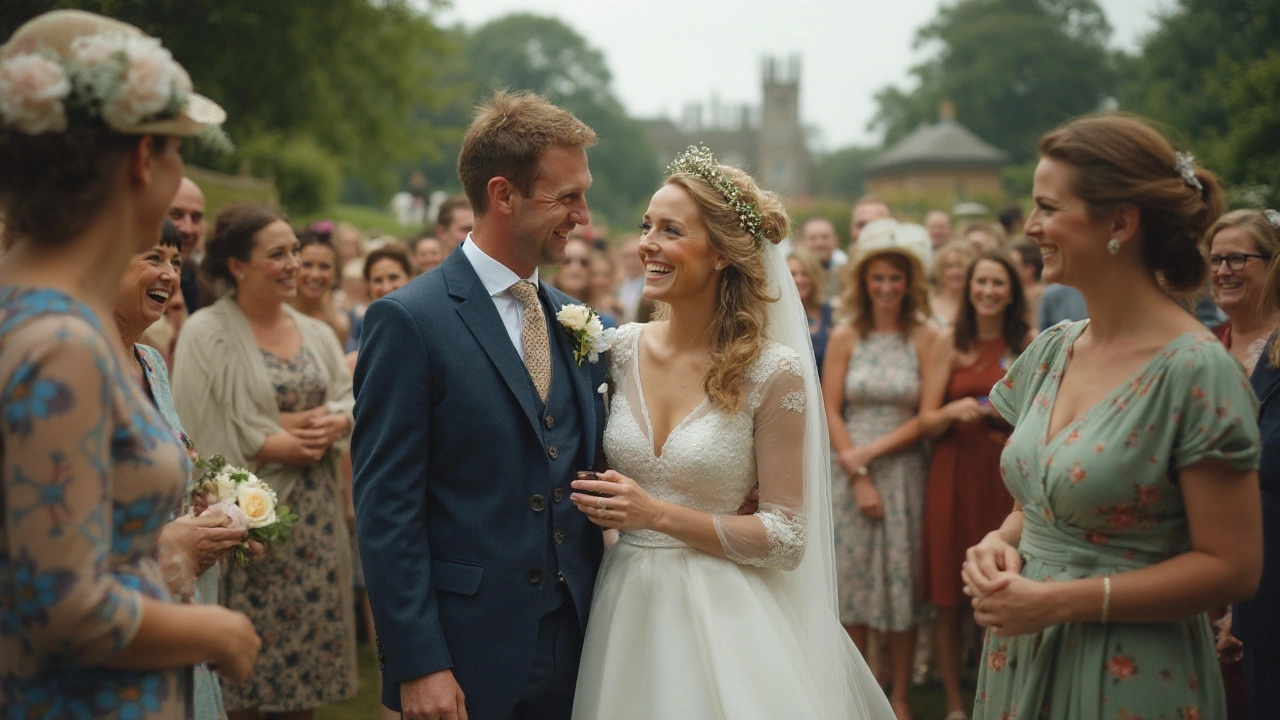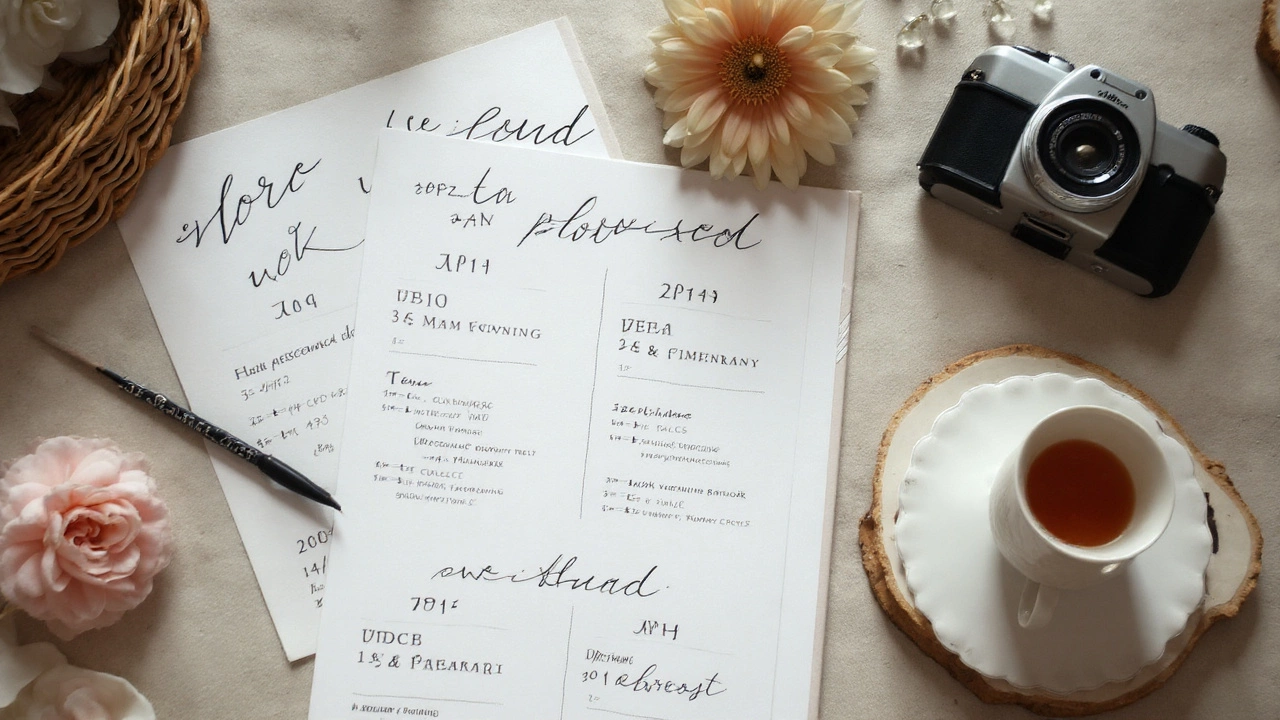How Many Hours Should You Book Your Wedding Photographer? Key Tips for Stress-Free Wedding Photos
 Aug, 8 2025
Aug, 8 2025
Ever noticed how couples argue more about photos than about the fish or the flowers? Most people don't realise that your wedding day's timeline pretty much hangs on the hours you book your wedding photographer hours. Get it wrong, and you might miss all the fun bits—or find yourself posing when you should be dancing. Let's look at how much time is really needed, what's common in Australia, and what actually happens during those hours behind the camera.
What Does a Wedding Photographer Actually Do All Day?
Plenty of couples imagine that their wedding photographer just pops up for group photos and the kiss at the altar. Sounds simple, right? But the typical day for a wedding photographer is a game of constant movement, hustle, and big library of mental checklists. From the moment they arrive, they’re juggling lenses, finding the best light, and giving gentle pep talks so you look relaxed even if you’re sweating buckets inside your suit.
The job starts way before the guests arrive. Most wedding photographers in Melbourne get there while you’re still in pajamas, taking photos of details like rings, invitations, shoes, and yes, that quirky cake topper you bought online at 2 am. Early shots capture the special nerves—your mum adjusting your dress, your best mate nearly poking his eye out with cufflinks. These aren’t just extra snaps. They step up the story that a thousand words can’t tell.
Once the ceremony rolls around, the photographer becomes a ninja, dodging overzealous aunts and kids with smartphones, angling for those once-in-a-lifetime shots. When the confetti flies, they're catching your reactions and scanning for those ‘wow’ moments among the crowd. After the I Do’s, the focus turns to group photos, couple portraits, and the “let’s see if anyone blinks” marathon. The night shifts gears at the reception, and now it’s about laughter, tears, dance floor disasters, and the speeches that will haunt the YouTube generation.
On a busy day, Melbourne wedding photographers burn more calories than a gym instructor. A study by the Australian Institute of Professional Photography showed wedding photographers cover an average of 12-15 km on foot during an average wedding. That’s more than most sports players during a soccer match. All this energy means every hour actually packs in a lot of different moments and scenes, not just posed portraits.
How Many Hours Do Most Couples Book—and Why?
When couples ask, “How many hours do we need?”, the first thing to nail down is what type of day you’re planning. In Australia, standard bookings are eight hours. Interested in hard stats? A 2024 report by Easy Weddings found 76% of Victorian couples booked their photographer for 7-9 hours. Of those, 51% went for full-day coverage—usually starting with morning preparations and ending just after the first dance.
Why eight hours? Here’s a typical schedule:
- 2 hours: Morning prep (hair, makeup, getting-ready moments, detail shots)
- 1 hour: Travel and guest arrivals at ceremony
- 1 hour: Ceremony
- 1.5 hours: Group shots, couple portraits, mingling
- 2.5 hours: Reception highlights (entrance, speeches, cake, dancing)
- Extra time: Transitions, sneaky candid shots, occasional overtime
This schedule isn’t set in stone. If your ceremony is at sunset, you might start later. If you’re planning a wild afterparty, you may want your photographer to stay late for those infamous “last wave” shots. A typical ballroom wedding can work with 8 hours, but if you’ve got a huge Greek-Lebanese affair with 500 guests and tons of traditions, you could be looking at 10-12 hours easy.
| Hour Block | What Happens |
|---|---|
| 1-2 | Morning prep (hair, makeup, details) |
| 3 | Travel, guests arriving |
| 4 | Ceremony |
| 5-6 | Group and couple photos |
| 7 | Reception begins, speeches |
| 8 | First dance, cake, party shots |
Short days—say, just the ceremony and a bit after—are usually 4-6 hours. Elopements and micro-weddings keep things compact. Longer days, up to 12 hours, work for big cultural ceremonies or when venues are far apart.

How to Figure Out How Many Hours You Really Need
It’s tempting to go by recommendations alone, but every wedding is its own adventure. First, think about what you truly want captured. If dress-up antics and emotional first looks make your heart flutter, you’ll want to cover the pre-wedding fun. If you care most about the wild dance floor, late-night toasts, or a sparkler send-off, push your hours later into the night.
Grab your schedule and try this: make a simple timeline, working backward from the reception finish. Slot in your ceremony time, how long you expect it to run (be brutally honest), and build in some breathing room for late arrivals. Drop in group photos and couple shots after the ceremony—these always take longer than you think, especially when wrangling kids, tipsy groomsmen, or grandparents with mobility issues.
Here’s a practical hack: if your wedding day has a lot of travel—say, switching venues or squeezing in a city rooftop session—add an extra hour to be safe. In Melbourne, traffic can turn a quick trip into a 45-minute crawl; don’t let it steal your photo time. Ask your photographer if they count travel in their package. Some do, others only start the clock once they arrive.
Want almost every main event covered, but don’t need seven million dance floor photos? Many couples split coverage between two photographers. Second shooters mean you can get both the bride and groom prep at the same time, or dramatic crowd shots while the main photographer focuses on you. This option generally adds 20-30% to the price, but really delivers variety—especially handy for big or split-location weddings.
Sometimes, photographers have pre-set packages: 4, 6, 8, or even 12 hours. If you’re stuck, ask for custom coverage. Good photographers are often happy to work out tailored timeframes, as long as you’re clear on your timeline. Above all, don’t skimp if you think you’ll regret missing key moments. Plenty of couples wish they booked just one or two extra hours.
Making Your Hours Count: Top Tips from Melbourne Pros
Getting the most out of your photography hours isn’t about cramming more photos into less time. It’s about using your hours cleverly—so your gallery tells a full, exciting story. Melbourne’s top wedding photographers share a few of their real-life tricks for squeezing every drop of magic from the hours you book.
- Be realistic with travel. City weddings mean traffic. Ask your photographer for their best guess—and trust them. They know how long it takes to get from a sleepy AirBnB in St Kilda to a Fitzroy warehouse at peak hour.
- Plan with your photographer. Good photographers are natural planners. Don’t just send them an invite; give them your full timeline in advance so they can flag risks or suggest tweaks.
- Maximise your getting-ready photos. If you want both partners’ prep covered but can’t afford extra hours, get ready in the same hotel or in homes that are close by.
- Skip the formal exit. Not every couple wants an elaborate send-off. If you’re fizzling out after midnight, let the photographer go after the cake or first dance—it saves you money and they’ve usually captured the party’s peak anyway.
- Don’t force the timeline. Some of the best photos happen in the quiet moments when everyone forgets a camera is there. Build in downtime, and don’t stress if things slip by 15 minutes.
Here’s a quirky fact: some couples in Melbourne now book photographers for two mini sessions—one during the morning prep and ceremony, and another just for the last hour of the night. This approach nabs both the classic wedding story and the rowdy closing moments. Just make sure your pro is open to the split shift.
Finally, sanity tip: your wedding is made for living, not just posing. Don’t let the chase for perfect photos eat up every happy moment. When in doubt, talk it out with your photographer—they’ve seen every type of wedding and know what works. Book enough hours to soak up the day, trust their eye, and you’ll end up with photos that don’t just look good, but actually feel like you.